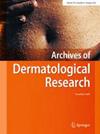Chlorogenic acid targets SIRT6 to relieve UVB - induced UV damage
Abstract
Skin photoaging, one of the most critical types of exogenous skin aging, occurs when the skin is exposed to excessive ultraviolet radiation, leading to a series of skin-aging problems. The objective of this study was to utilize keratinocytes (HaCaT) treated with medium wave ultraviolet (UVB) as a photoaging model to investigate the anti-photoaging activity of chlorogenic acid (CGA) and preliminarily elucidate its underlying mechanism. The crystal violet assay shows that both 100 and 150 µM of CGA can significantly suppress the cell damage induced by 21.6 mJ/cm² UVB. Furthermore, the results of comet electrophoresis and Western Blot (WB) experiments demonstrate that CGA and OSS-128,167 (SIRT6 inhibitor) can effectively inhibit DNA damage caused by UVB, thereby alleviating cell apoptosis. The co-immunoprecipitation (CO-IP) and WB results suggest that CGA and OSS-128,167 can effectively suppress the activity and expression of the deacetylase of SIRT6, thus enhancing the expression of DDB2 and activating the nucleotide excision repair (NER) of cells to achieve the anti-photoaging effect. The aforementioned results imply that CGA activates NER repair and protects cells from UVB-induced damage by inhibiting the deacetylation activity of SIRT6 and subsequently decreasing the deacetylation modification of DDB2. The study elucidates the molecular mechanisms underlying the beneficial effects of CGA on skin photoaging and establishes a theoretical basis for the development of CGA based sunscreen formulations.

 求助内容:
求助内容: 应助结果提醒方式:
应助结果提醒方式:


